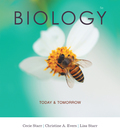
EBK BIOLOGY TODAY AND TOMORROW WITH PHY
5th Edition
ISBN: 9781337509572
Author: STARR
Publisher: YUZU
expand_more
expand_more
format_list_bulleted
Concept explainers
Question
Chapter 4, Problem 1SQ
Summary Introduction
Introduction: “Energy cannot be created and destroyed, but it can be converted from one form to another”. The plant uses sun light energy to make sugar molecules. In the plant cell, the chloroplast harvests energy from light that is transferred to another set of molecules. The second set of molecules uses the energy to form sugar from carbon dioxide and water. This particular sunlight energy involves the conversion of light energy to chemical energy. Most of the cellular activity is carried out by transfer of chemical energy from one molecule to another molecule.
Expert Solution & Answer
Want to see the full answer?
Check out a sample textbook solution
Students have asked these similar questions
A 25-year-old woman presents to the emergency department with a 2-day history of fever, chills, severe headache, and confusion. She recently returned from a trip to sub-Saharan Africa, where she did not take malaria prophylaxis. On examination, she is febrile (39.8°C/103.6°F) and hypotensive. Laboratory studies reveal hemoglobin of 8.0 g/dL, platelet count of 50,000/μL, and evidence of hemoglobinuria. A peripheral blood smear shows ring forms and banana-shaped gametocytes. Which of the following Plasmodium species is most likely responsible for her severe symptoms?
A.
Plasmodium vivax
B.
Plasmodium ovale
C.
Plasmodium malariae
D.
Plasmodium falciparum
Standard Concentration (caffeine) mg/L
Absorbance Reading
10
0.322
20
0.697
40
1.535
60
2.520
80
3.100
Please draw in the missing answer, thank you
Chapter 4 Solutions
EBK BIOLOGY TODAY AND TOMORROW WITH PHY
Ch. 4 - Figure 4.5 Energy inputs and outputs in chemical...Ch. 4 - Figure 4.10 Enzymes, temperature, and pH. Each...Ch. 4 - Prob. 3FIOCh. 4 - Prob. 4FIOCh. 4 - The genus Ferroplasma consists of a few species of...Ch. 4 - Prob. 2DIDCh. 4 - Prob. 3DIDCh. 4 - Prob. 1SQCh. 4 - Prob. 2SQCh. 4 - Prob. 3SQ
Ch. 4 - Prob. 4SQCh. 4 - Prob. 5SQCh. 4 - Prob. 6SQCh. 4 - Prob. 7SQCh. 4 - Prob. 8SQCh. 4 - Ions or molecules tend to diffuse from a region...Ch. 4 - Prob. 10SQCh. 4 - Prob. 11SQCh. 4 - Prob. 12SQCh. 4 - A transport protein requires ATP to pump sodium...Ch. 4 - Prob. 14SQCh. 4 - Prob. 15SQCh. 4 - Prob. 1CTCh. 4 - Water molecules tend to diffuse in response to...Ch. 4 - Dixie Bee wanted to make JELL-O shots for her next...Ch. 4 - The enzyme trypsin is sold as a dietary enzyme...Ch. 4 - Prob. 5CT
Knowledge Booster
Learn more about
Need a deep-dive on the concept behind this application? Look no further. Learn more about this topic, biology and related others by exploring similar questions and additional content below.Similar questions
- a. On this first grid, assume that the DNA and RNA templates are read left to right. DNA DNA mRNA codon tRNA anticodon polypeptide _strand strand C с A T G A U G C A TRP b. Now do this AGAIN assuming that the DNA and RNA templates are read right to left. DNA DNA strand strand C mRNA codon tRNA anticodon polypeptide 0 A T G A U G с A TRParrow_forwardplease answer all question below with the following answer choice, thank you!arrow_forwardplease draw in the answeres, thank youarrow_forward
- A) What is being shown here?B) What is indicated by the RED arrow?C) What is indicated by the BLUE arrow?arrow_forwardPlease identify the curve shown below. What does this curve represent? Please identify A, B, C, D, and E (the orange oval). What is occurring in these regions?arrow_forwardPlease identify the test shown here. 1) What is the test? 2) What does the test indicate? How is it performed? What is CX? 3) Why might the test be performed in a clinical setting? GEN CZ CX CPZ PTZ CACarrow_forward
- Determine how much ATP would a cell produce when using fermentation of a 50 mM glucose solution?arrow_forwardDetermine how much ATP would a cell produce when using aerobic respiration of a 7 mM glucose solution?arrow_forwardDetermine how much ATP would a cell produce when using aerobic respiration to degrade one small protein molecule into 12 molecules of malic acid, how many ATP would that cell make? Malic acid is an intermediate in the Krebs cycle. Assume there is no other carbon source and no acetyl-CoA.arrow_forward
arrow_back_ios
SEE MORE QUESTIONS
arrow_forward_ios
Recommended textbooks for you
 Concepts of BiologyBiologyISBN:9781938168116Author:Samantha Fowler, Rebecca Roush, James WisePublisher:OpenStax College
Concepts of BiologyBiologyISBN:9781938168116Author:Samantha Fowler, Rebecca Roush, James WisePublisher:OpenStax College Basic Clinical Lab Competencies for Respiratory C...NursingISBN:9781285244662Author:WhitePublisher:Cengage
Basic Clinical Lab Competencies for Respiratory C...NursingISBN:9781285244662Author:WhitePublisher:Cengage Human Biology (MindTap Course List)BiologyISBN:9781305112100Author:Cecie Starr, Beverly McMillanPublisher:Cengage LearningUnderstanding Health Insurance: A Guide to Billin...Health & NutritionISBN:9781337679480Author:GREENPublisher:Cengage
Human Biology (MindTap Course List)BiologyISBN:9781305112100Author:Cecie Starr, Beverly McMillanPublisher:Cengage LearningUnderstanding Health Insurance: A Guide to Billin...Health & NutritionISBN:9781337679480Author:GREENPublisher:Cengage

Concepts of Biology
Biology
ISBN:9781938168116
Author:Samantha Fowler, Rebecca Roush, James Wise
Publisher:OpenStax College


Basic Clinical Lab Competencies for Respiratory C...
Nursing
ISBN:9781285244662
Author:White
Publisher:Cengage

Human Biology (MindTap Course List)
Biology
ISBN:9781305112100
Author:Cecie Starr, Beverly McMillan
Publisher:Cengage Learning


Understanding Health Insurance: A Guide to Billin...
Health & Nutrition
ISBN:9781337679480
Author:GREEN
Publisher:Cengage
Microbial Nutrition and Growth; Author: Scientist Cindy;https://www.youtube.com/watch?v=rK3UkyWjkl8;License: Standard YouTube License, CC-BY